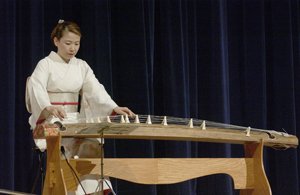Lesson Plan: Sakura
It’s April - that means that it’s time for the Cherry Blossoms to bloom. Here is a lesson plan that I wrote back when I was teaching that introduces students to the Japanese folksong, Sakura. The students are asked to learn more about the history of the song, listen to a recording, then post a reflection/response. Afterwards, students will use a notation program to compose a rhythmic accompaniment to the melody of Sakura. Hope this lesson plan is useful!
Objectives:
The students will demonstrate their understanding of the pentatonic scale by performing the melody to Sakura.
The students create a rhythmic accompaniment scored for two traditional Japanese percussion instruments.
The students notate their rhythmic accompaniment using the blank score provided.
The students will compare and contrast each others work, and discuss the stylistic qualities of each accompaniment.
Materials:
Notation program such as Flat for Education or Noteflight Learn.
Student Handout
Sakura, which means Cherry Blossoms in the Japanese language, is one of the most famous melodies in Japan. It is a very old song, originally known by the name of Saita Sakura. Children all over Japan love to sing this song. The words to the song are from a poem written by Tsuge Gen’ichi.
Listen to this traditional version of Sakura. It features the Shakuhachi and Koto.
Lyrics:
Cherry blossoms, cherry blossoms, in the March sky,
As far as one can see -
A mist? A cloud?
Their fragrance fills the air. Come, everybody!
Let's go and see them.
Traditionally, Sakura is played on an instrument called the Koto. It is one of the first tunes a Koto player learns. In the musical score that you were also given, you will see three other traditional Japanese instruments, the Shakuhachi, Temple Blocks, and Taiko drum. If you would like to learn more about the Koto, and even play a virtual one on the Internet, visit: www.genkienglish.net/genkijapan/koto.htm.
Sakura is written in a pentatonic scale, which means that it only has five different notes. There are many different pentatonic scales, and Sakura is written in a Japanese version known as the In scale. The notes that Sakura uses are: E, F, A, B and C.
The koto is a traditional Japanese stringed musical instrument derived from the Chinese zheng, and similar to the Mongolian yatga, the Korean gayageum, and the Vietnamese đàn tranh. The koto is the national instrument of Japan.
They have 13 strings that are usually strung over 13 movable bridges along the width of the instrument. There is also a 17-string variant. Players can adjust the string pitches by moving the white bridges before playing. To play the instrument, the strings are plucked using three finger picks (thumb, index finger, and middle finger).
Shakuhachi
The shakuhachi is a Japanese longitudinal, end-blown bamboo-flute.
It was originally introduced from China into Japan in the 6th century and underwent a resurgence in the early Edo period. The shakuhachi is traditionally made of bamboo, but versions now exist in ABS and hardwoods. It was used by the monks of the Fuke sect of Zen Buddhism in the practice of suizen (blowing meditation).
The instrument is tuned to the minor pentatonic scale.
Taiko Drums
Taiko are a broad range of Japanese percussion instruments. In Japanese, the term refers to any kind of drum, but outside Japan, it is used to refer to any of the various Japanese drums called wadaiko and to the form of ensemble taiko drumming more specifically called kumi-daiko ("set of drums").
The process of constructing taiko varies between manufacturers, and preparation of both the drum body and skin can take several years depending on method.
Often, 3 sizes of daiko are played together: chu-daiko (low/large), okedo-daiko (medium), shime-daiko (high/small).
Temple Blocks
A temple block (mokugyo) is a slit-drum - a woodblock hollowed out for extra resonance. They are used to keep the beat in the traditional chants of the Buddhist religion.
Traditional temple blocks are often carved to look like a fish, and may be painted. You can hold small temple blocks to play them. Large ones are laid on a cushion.
Western temple blocks are often plain in design, and may be rounded or rectangular. Sets of temple blocks are sometimes used in schools, jazz, and concert bands. Usually, each set forms a pentatonic scale and is mounted on a rack to be played.
Student Task #1
Listen to "Sakura" and post a response.
What do you notice about the music? Use musical vocabulary to describe the sound.
How does the song make you feel? You can discuss the music or the lyrics.
Tell about how you connect to this song. Maybe you have performed it or it reminds you of and experience you have had. Maybe it reminds you of another piece of music, art or poetry.
Student Task #2
Now that you know a little bit about the song, you will compose a percussion part using a Taiko drum and Temple Blocks using a notation program.
***use either the MusicXML or MIDI file included above in your favorite notation program. I suggest an online option such as Flat for Education or Noteflight Learn.




